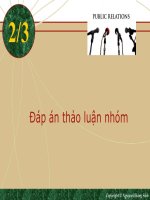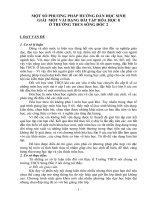Thảo luận nhóm TMU the main features of the investment tribunal system under the EU vietnam investment protection agreement (EVIPA)
Bạn đang xem bản rút gọn của tài liệu. Xem và tải ngay bản đầy đủ của tài liệu tại đây (83.54 KB, 16 trang )
2
TABLE OF CONTENTS
3
PREAMBLE
Investor- State dispute settlement (ISDS) system varies through times.
Indeed, there have been different ways for a dispute to be settled, however, the
most effective, or proper way to that is a fundamental question in recent practice
of the offices or parties that own the right to settle the dispute. Furthermore,
although have been used from times to times until now, the executing of ad hoc
tribunals have delivered many setbacks and disadvantages to the parties, especially
to investors against States1. In its recent treaties with Vietnam, the European Union
(EU) has established a new model of investor-State dispute settlement system 2- a
court-like system in many viewpoints3. For the above reasons, in this research
paper, I will address and analyse the main features of the Investment Tribunal
System under the EU- Vietnam Investment Protection Agreement (EVIPA). These
features will be served for the purpose of identify the differences in investment
1 Dang-Khoa Le (2020), An overview of the dispute settlement mechanism in the European Union - Vietnam
Investment Protection Agreement: What is a Court-like system?, < > (Accessed: 10
Sept 2020)
2 N Jansen Calamita (2017), The Challenge of Establishing a Multilateral Investment Tribunal at ICSID, <
> (Accessed: 10 Sept 2020)
3 Dang-Khoa Le (2020); Id.
4
dispute settlement system of the ICSID Convention and the EU initiative model of
system.
CONTENTS
I. The EU-Vietnam IPA: An overview
The EVIPA, the agreement between Vietnam and the European Union on
Investment Protection, is a significant one to Vietnam in part and to the change of
the ISDS reform in general. In February 2020, the European Parliament gave
consent to the EVIPA and the EVFTA (the Free Trade Agreement between EU and
Vietnam). In March 2020 and June 2020, respectively, the EU Council and
Vietnamese National Assembly approved the agreements. On 30 June 2020, these
agreements were noticed to enter into force on 1 August 2020. 4
Through times, Vietnam, a developing country with a population of 95
million, is a significant trading partner of the EU. The EU- Vietnam IPA
establishes specific protections for investors and creates, inter alia, dispute
4 Hende, Cannon, White and Jennifer (2020), European Parliament approves EU-Vietnam trade and
investment agreements: EU-Vietnam Free Trade Agreement to enter into force on 1 August 2020, <
>
(Accessed: 10 Sept 2020)
5
resolution system that allows private parties to bring actions against measures that
impact upon their investments.
In detail, the IPA provides for investor- state dispute settlement claims to be
resolved through and “Investment Tribunal System” composed of permanent first
instance and appeal tribunals. The specific and important features of that System
will be clarified below.
II. The main features of the Investment Tribunal System under the EUVietnam IPA
There shall be three main features that I aim to address here. Including: (i)
The establishment of a two-tiered system of tribunals; (ii) Standing, treaty-based
investment tribunals with judges appointed by the State parties; (iii) Allowing for
appellate review as of right on issues of law and fact; and (iv) Setting up an
enforcement mechanism for its own5. Besides that, the definitions, interpretation
and the impacts stem from that features shall be mentioned. At some points, there
shall be some comparison to other system, especially to the ICSID system, to
5 N Jansen Calamita (2017), Id.
6
further show the effectiveness as well as the prospects of this initiative EU model
system to investor- state dispute settlement in regulatory area and in practice.
1. The establishment of a two-tiered system of tribunals, comprising first
instance and appellate bodies
The Investment Tribunal System under the EVIPA has two level of tribunals,
the first instance (Tribunal) and the appellate body (Appeal Tribunal). This is very
different from the ICSID Convention system in ISDS. By its terms, the ICSID
Convention neither permits appeals, nor does it permit individual States or
disputing parties to agree to appellate processed among themselves. 6 This new EU
model entails a root-and-branch revision of investor-State arbitration, establishing
not only an appellate mechanism but also a standing two-tiered tribunal… 7 These
permanent tribunals will be formed of nine and six members respectively and of
nationals of Vietnam, EU Member States and third party states who fulfill certain
6 N Jansen Calamita (2017), Id.
ICSID Convention (n 7) art 53(1): ‘The award shall be binding on the parties and shall not be subject to any
appeal or to any other remedy except those provided for in this Convention.’ See also ICSID Convention (n 7) art 26:
‘Consent of the parties to arbitration under this Convention shall, unless otherwise stated, be deemed consent to such
arbitration to the exclusion of any other remedy.’ See Calamita (n 9) 604–13.
7 Compare ICSID Convention (n 7) art 37–40 and Transatlantic Trade and Investment Partnership (draft dated
12 November 2015) (TTIP) art 9; EU–Vietnam FTA (n 3) art 12; CETA (n 2) art 8.27
7
expertise requirements and are subject to a code of conduct. 8 Therefore, this makes
the arbitration system of EVIPA become a hybrid system, in which the half of the
system is like arbitration and the other like the domestic Court system. 9 The new
two-tiered system is a breakthrough in ISDS, with the purpose of improve the
unfavorable situation to the parties in a dispute under the previous ICSID system
that cannot brings the awards further to appellate procedure.
2. Standing, treaty-based investment tribunals, staffed with judges
appointed by the State parties
If the arbitral system organization is a new approach in EVIPA and the older
one – ACIA regarding dispute mechanism, the way of naming arbitrators and the
matters regarding them in EVIPA are unprecedented. The selection arbitrator
system in EVIPA is totally different. 10
8 Hende, Cannon, White and Jennifer (2020), Id.
9 Dang-Khoa Le (2020), Id.
10 Dang-Khoa Le (2020), Id.
8
Firstly, the number of arbitrators shall not set at three but being flexible.
Accordingly, the number of arbitrators could be decreased or increased by
multiples of three11 in complying with the decision of the EVIPA’s
Committee12.This gives the Committee a right of decision to react with particular
circumstances. It means the change of the number of the case which the tribunal
(appeal tribunal) must settle. If the number is low, it is unnecessary to remain nine
members of the tribunal and vice versa in case of the tribunal at the first stage.
Secondly, the tribunal (appeal tribunal) is not an ad hoc system. Therefore, it
has a fixed quantity of arbitrator at the beginning13:
Pursuant to subparagraph 5(a) of Article 4.1 (Committee), the Committee
shall, upon the entry into force of this Agreement, appoint nine Members of the
Tribunal. Three of the Members shall be nationals of a Member State of the Union,
three shall be nationals of Viet Nam and three shall be nationals of third countries.
11 EVIPA, Chapter 3, Section B, Article 3.38(3) and Article 3.39(4)
12 The Committee according to EVIPA is an agency having the mission of reviewing, observing and
implementing EVIPA. It is structured with the Minister of Planning and Investment of Vietnam and the Member of
the European Commission responsible for trade (or their respective delegates) as co-chaired (see EVIPA, Chapter 4,
Article 4.1).
13 The ISDS mechanism in EVIPA shall be established at the time EVIPA come into force and prevailed like
a Court system to resolve any disputes arising from EVIPA (see EVIPA, Chapter 3, Section B, Article 3.38(1) and
Article 3.39(3))
9
Pursuant to subparagraph 5(a) of Article 4.1 (Committee), the Committee
shall, upon entry into force of this Agreement, appoint the six Members of the
Appeal Tribunal.
Thirdly, the member of the tribunal (appeal tribunal) shall not be ad hoc
arbitrators but being term-member with a four-year term and they are renewable
only once14. It means that the member of the tribunal (appeal tribunal) shall be
elected like a full-time “judge”. And for serving that purpose, the number four,
arbitrators are paid an amount monthly as salary for their efforts 15.The amount shall
be decided by the Committee with the budget contributed and maintained by
Vietnam and the EU16.
Last but not least, the arbitrators of the tribunal (appeal tribunal) are
prohibited to act “double-hatting”. It means that the members of the arbitration are
not allowed to be counsel or expert or witness during the time they are appointed
as arbitrators17. This idea is based on the critics from opponents of traditional ISDS
14 EVIPA, Chapter 3, Section B, Article 3.38(5) and Article 3.39(5)
15 EVIPA, Chapter 3, Section B, Article 3.38(14) and Article 3.39(14)
16 EVIPA, Chapter 3, Section B, Article 3.38(15) and Article 3.39(15)
17 EVIPA, Chapter 3, Section B, Article 3.40
10
mechanism, in which opponents argue that “double-hatting” arbitrators might not
be independent to act as the arbitrators if their roles are both decision-maker and
advocator at the same time.18
As of above, the structure of the Tribunal and Appeal Tribunal is
unprecedented and has a wide scope of change in comparison to other Vietnam v.
other parties agreements or treaties such as ICSID, ACIA and CPTPP, and so on.
3. Allowing for appellate review as of right on issues of law and fact
The EVIPA provides that a decision of the Tribunal may be appealed within
90 days of its issuance to an ‘Appeal Tribunal’19. In particular, the Appeal Tribunal
has the power to modify or reverse first instance awards, as opposed to simply
annulling an award in whole or in part. The scope of remedial power accorded to
the Appeal Tribunal is also much expanded, allowing the Appeal Tribunal to
intervene on issues of merit. In contrast to the limited grounds for annulment
specified in the ICSID Convention, the Appellate Tribunal may uphold, modify, or
18 Dang-Khoa Le (2020), Id.
19 EVIPA, Chapter 3, Section B, Article 3.54(1)
11
reverse an award based on: ‘(a) errors in application or interpretation of the
applicable law; (b) manifest errors in appreciation of the facts, including the
appreciation of relevant domestic law; (c) the grounds set out in Article 52(1)(a)
through (e) of the ICSID Convention, in so far as they are not covered by
paragraphs (a) and (b).’20 Combining the possible grounds of appeal in this way
helps to relieve the Appeal Tribunal from having to address potentially redundant
arguments, as certain grounds for annulment (e.g. manifest excess of power) might
be subsumed in the review for legal or jurisdictional error.21
4. Setting up an enforcement mechanism for its own
Accordingly, the decision awarded under EVIPA shall bind the assigned party
as if the decision was a final judgment of its domestic Court 22. Unfortunately, this
enforcement mechanism shall not be in force until the next five years after EVIPA
20 EVIPA, Chapter 3, Section B, Article 3.54(1)
21 Elsa Sardinha (2017), The New EU-Led Approach to Investor-State Arbitration: The Investment Tribunal
System in the Comprehensive Economic Trade Agreement (CETA) and the EU–Vietnam Free Trade Agreement, <
> (Accessed: 12 Sept 2020)
22 EVIPA, Chapter 3, Section B, Article 3.57(2)
12
was ratified.23 Therefore, in the first five years, the enforcement shall have
complied with the regulations under the New York Convention on the Recognition
and Enforcement of Foreign Arbitral Awards 1958 (New York Convention). It
means that judgment in EVIPA in the first five years shall be considered as foreign
arbitration’s decisions and it will be treated like other foreign arbitration’s
decisions. During this transition period, Vietnam’s consent to engage in the dispute
as the respondent shall not be considered. However, Vietnam still has the right to
seek any solution to appeal, review, set aside, annulment or any other remedy for
protecting themselves24. Frankly speaking, there is nothing sure to say that
Vietnam shall comply with arbitral awards against them or their state-owned
entities in this first five-year period. It shall be a story of time, indeed.25
CONCLUSION
23 EVIPA, Chapter 3, Section B, Article 3.57(3)(4)
24 EVIPA, Chapter 3, Section B, Article 3.57(1)(b) and Article 3.57(4)y.
25 Dang-Khoa Le (2020),Id.
13
By the characteristics have been analyzed above, the new Investment
Tribunal System has many prospects and advantages. Notwithstanding, we have to
wait for it to be enforced in the ISDS in real life to evaluate the pros and cons and
its impacts on solving the disputes. The fact that the EU has included this in
EVIPA and some other agreements shall be the very first steps of initiative a new
multilateral investment tribunal system in ISDS, which has such identical features
as of the Tribunal system under EU- Vietnam IPA./.
14
REFERENCES
1. ICSID Convention, Regulations and Rules of the International Centre for
Settlement of Investment Disputes (entered into force on October 14, 1966)
(ICSID Convention);
2. Convention on Recognition and Enforcement of Foreign Arbitral Awards
(opened for signature 10 June 1958, entered into force 7 June 1959) (New York
Convention);
3. EU- Vietnam Investment Protection Agreement (EVIPA);
4. N Jansen Calamita (2017), The Challenge of Establishing a Multilateral
Investment Tribunal at ICSID, <
> (Accessed: 10
Sept 2020)
5. Elsa Sardinha (2017), The New EU-Led Approach to Investor-State
Arbitration: The Investment Tribunal System in the Comprehensive Economic
15
Trade Agreement (CETA) and the EU–Vietnam Free Trade Agreement, <
>
6. Dang-Khoa Le (2020), An overview of the dispute settlement mechanism in
the European Union - Vietnam Investment Protection Agreement: What is a Courtlike system?, < >
7. Hende, Cannon, White and Jennifer (2020), European Parliament
approves EU-Vietnam trade and investment agreements: EU-Vietnam Free Trade
Agreement to enter into force on 1 August 2020, <
>
16









